Schumacher Electric is a well-known manufacturer of battery chargers, which come in various types and sizes to cater to the needs of different users, from automotive enthusiasts to professional mechanics. Regardless of the type of battery charger you have, using it correctly is essential to ensure your battery’s longevity and reliability.
In this article, we will guide you through the steps on using a Schumacher battery charger effectively, whether you are a novice or an experienced user.
Schumacher Battery Charger: How Does It Work?
Before using any battery charger, it is essential to read the product description and manual carefully. This will give you a better understanding of the charger’s features, functions, and limitations. Schumacher is a reputable brand that produces high-quality battery chargers, and their products are widely used in the automotive industry. In terms of products, Schumacher currently offers EV chargers, conventional battery chargers, maintainers, jump starters, portable power sources, diagnostic instruments, battery accessories, LED indicators, lithium-powered devices, and more.
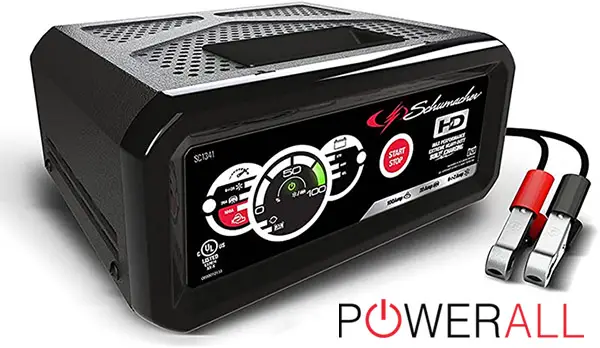
It is designed to charge all types of lead-acid batteries, including deep-cycle, gel-cell battery, and AGM batteries. The charger has advanced features such as automatic voltage detection, multi-stage charging, and reverse polarity protection, making it easy and safe to use.
It has an output voltage selector switch that allows you to select the appropriate voltage level for your battery. Besides, it contains an ampere rating that determines its charging speed and an amp-hour (Ah) rating that measures the battery’s capacity. The charger’s capacity determines how fast it can charge a battery, with higher-capacity chargers able to charge batteries faster. Additionally, some models come with additional features, such as a battery tester and a jump starter, making them versatile and convenient to use.
The charger typically comes with a control panel that displays charging status, amperage, voltage, and mode. The charger has three modes: Charge mode, Boost mode, and Engine start feature. It also comes with cables and clamps that connect to the battery.
Schumacher Battery Charger: How To Read It?
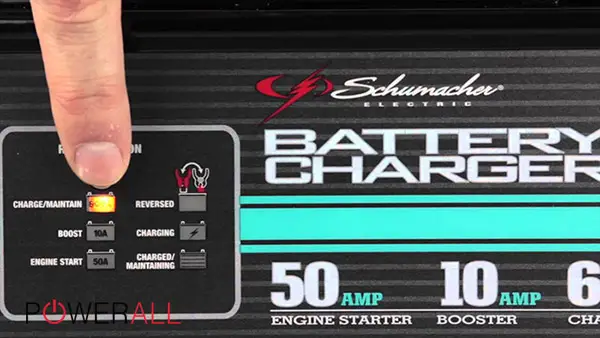
Before using the Schumacher Battery Charger, it is essential to understand its features and components. There will be 4 main parts on the charger:
The Red Start/Stop button:
This button is in the center of the charger, allowing you to begin or stop charging the battery.
The digital display:
After you press the red button in the middle, you will see the voltage number on the screen. Around the screen are 3 LEDs, indicating Percentage, Voltage, Charging status, and Charged/Maintaining.
- The voltage LED shows the current voltage of the charging battery (a fully charged and healthy one should measure 12.6V or more).
- The yellow Charge light tells you that the vehicle battery is being charged.
- When the Charged/Maintaining light turns on, you know your battery has finished its charging cycle and entered a maintaining state for optimum battery health.
- The Percentage LED signals the battery life in %, which is quite tricky to get the reading. To read this figure, you need to push the Start/Stop button again; you can hear the fan sound at this point. Next, press the Rate Selection button until the 2A Charge selection lights up. You can see the Percentage light turns on at this point, and the percentage of the battery life will show up on the screen.
The left side:
You can pick the charging rate for your battery: 2A Charge, 30A Boost (the most common selection), 100A Engine Start, and Clamps Reversed.
The right side:
This part lets you choose your battery type: Standard, Gel, AGM, or Bad Battery (this will illuminate when your battery can’t hold a charge or have any issues). Most batteries will go with the Standard one.
Schumacher Battery Charger Instructions
When using the Schumacher Battery Charger, the instructions will depend on whether the battery is still in your car or has been removed. Here are some basic instructions for both scenarios:
When The Battery Is Still In Your Car
Step 0: Safety precautions: Before you begin, turn off your car’s engine and any accessories like the radio or lights. Also, remove any metal jewelry or watches and wear complete eye protection to protect your eyes from any potential sparks.
Make sure the charger is unplugged from the wall and that the cables aren’t damaged.
Step 1: Locate the battery: The first step is to find your car’s battery. In most vehicles, the battery sits under the hood, but it can also be in the trunk or under a seat in some models. Refer to your car’s owner’s manual if you’re not sure where to find it.
Step 2: Connect the charger: Attach the output clips or cords to the battery terminals. Once you’ve located the battery, connect the positive (red) clamp on the Schumacher Battery Charger to the positive post on your car’s battery.
The positive terminal is typically labeled with a “+” symbol. Then, connect the negative (black) clamp to a metal part of your car’s frame or engine block. This will serve as the ground connection for the charger.
Step 3: Set the charger: Set the charger to the correct voltage and charging mode for your battery. Schumacher battery chargers usually come with an output voltage selector switch, which allows you to select the appropriate voltage for your battery. Remember to choose the correct voltage to avoid damaging the battery.
Decide on the charging rate you want and the charge time. The charging time for your battery will depend on its original condition and the rating of the charger.
Some have an amp meter that shows the circuit current and the charging status, while some come with a charge rate selector switch, which allows you to choose the lowest rate for slow charging.
Step 4: Start charging: Once the charger is connected and set up, plug it into an outlet and turn it on. The charger will begin charging your car’s battery. Schumacher’s battery typically requires an electrical outlet to function.
Plug the charger into a standard 120V AC outlet to start the charging process. Most Schumacher battery chargers use multi-stage charging, which efficiently charges the battery and extends its life.
Step 5: Disconnect from the AC outlet: Turn off the charger once the battery is fully charged and unplug it from the wall. Then, disconnect the negative clamp from your car’s frame or engine block first, followed by the positive clamp on the battery. Make sure to handle the clamps with care and avoid touching the metal parts.
When The Battery Is Removed From Your Car
If you have removed the battery from your car, follow the below instructions:
Step 0: It’s important to take some safety precautions before using any battery charger.
Ensure you’re in a well-ventilated area and wear gloves and eye protection. Although the charger comes with hook-up protection that prevents sparks or short circuits, you should also wear clothing protection to prevent burns or shock. Clean battery terminals to keep your battery vehicle free of any corrosion.
Then, check the polarity of the battery posts. The positive pole is typically larger in diameter than the negative post. Improper connection can damage your battery or the charger and even result in a risk of explosion.
Step 1: Connect the positive (red) clamp to the positive terminal of the battery and the negative (black) clip ungrounded post of the battery for a negative-grounded car. Ensure that you connect the clips or cords to the correct polarity of the battery posts, as reversing them could damage the battery or the charger.
Step 2: Once the charger is connected to the battery, turn it on and select the desired charging mode. It usually offers different charging modes, such as manual, automatic, or multi-stage charging, depending on the type of battery.
Step 3: If the battery is a gel or deep-cycle battery, use the lowest rate to prevent damage. Choose the correct mode based on your battery type and the condition of your battery. The charger will begin charging the battery automatically.
Step 4: Keep an eye on the charger throughout the charging process. The charger should display the charging status, including the charge level and any errors or warnings that may occur.
Schumacher chargers use advanced charging algorithms and microprocessor-controlled automatic charging to ensure efficient charging and optimum battery life.
Step 5: Once the battery is fully charged, disconnect the charger from the AC cord. Remove the negative (black) clamp first, then the positive (red) clamp.
When to Use Which Mode of the Schumacher Battery Charger?
The Schumacher charger features several modes that can be used depending on the battery’s size, type, and condition. Here are some of the modes and when to use them:
Using Charge Mode
The Charge mode is designed to charge batteries slowly and steadily, making it perfect for maintaining the charge of a battery that is not in use.
You can use this mode for batteries that are not completely discharged, and it is ideal for smaller batteries, such as those found in motorcycles, lawnmowers, and small boats.
Charge mode is also useful for keeping your battery maintained during the off-season, such as during winter storage.
Using Boost Mode
The Boost mode works wonders for quickly charging a deeply discharged or dead battery. It delivers a quick burst of energy to jumpstart your battery in a short period of time.
You can use this mode for larger batteries, like those found in cars, trucks, and boats. Boost mode can also be used to charge a partially discharged battery quickly.
We advise you to charge the internal battery in your portable power jump starter as soon as you get it, every 30 days, and after each use.
Using the Engine Start Feature
The Engine Start feature is designed to provide a surge of power to start an engine that is not turning over due to a low battery. This mode provides a high amount of current in a short period, which can help start the engine quickly.
You can use this feature for larger batteries, for example, those found in cars, trucks, and boats. The Engine Start feature should only be applied for a short period and only when needed.
Overall, always read the guide from the battery manufacturer before using your Schumacher battery charger, and ensure that you are using the appropriate mode for your type of battery, size, and level of charge. Remember, using the wrong mode can ruin your battery and reduce battery life.
Some Precautions When Using Schumacher Battery Charger
When using a Schumacher Battery Charger, it is essential to follow safety instructions to avoid personal injury, battery damage, or premature battery failure. Here are some tips to keep in mind:
- Read the instructions: Always read the instructions with the charger before using it. The manuals will provide important information about safely and correctly using the charger.
- Wear protective gear: Wear protective equipment such as gloves and safety glasses to protect yourself from sparks and battery acid.
Batteries can release harmful gasses that can be hazardous if inhaled, so it’s essential to protect your eyes and skin. In the event that battery acid gets on your skin, clothes, or eyes, wash them with plenty of fresh water and soap (not for eyes, though).
- Turn off the car: Turn off the vehicle and disconnect the battery cables before charging the battery. This will prevent any electrical shock or injury from occurring.
- Choose a well-ventilated area: Choose a well-ventilated area to avoid inhaling toxic fumes. The battery charger will produce hydrogen gas, which is highly flammable, so it’s essential to use the charger in a well-ventilated area.
- Ensure that the charger and cables are not damaged or corroded before use.
- Keep the charger away from moisture and heat sources.
- Do not touch the clamps or cables while the charger is in use.
- Disconnect the charger from the battery before removing or installing the battery.
Maintenance and Troubleshooting
Maintaining and troubleshooting your Schumacher Battery Charger is important to ensure its optimal performance and longevity.
Maintenance Tips
- Regularly clean the clamps and cables with a soft cloth to ward off corrosion and ensure good contact with the battery terminals. Use a wire brush or sandpaper to remove any rust or buildup.
- Check the charger’s cables for any frayed wires or damage. If you notice any damage, replace the cables immediately.
- Store your charger in a cool, dry place to prevent moisture damage and keep it away from direct sunlight.
- Use metal tools and avoid personal metal items when working with the charger.
- Periodically inspect the charger’s fuse and replace it if it’s blown.
- Apply the appropriate charging mode to the battery type and size you’re charging to ensure safe and effective charging.
Tips for Troubleshooting
- If the charger won’t turn on, ensure the power outlet is operational. Also, check the charger’s fuse and replace it when the outlet is functional.
- In case the charger is charging it, but it is not retaining a charge, then put a fresh battery in the device.
- Once there is an insufficient electrical connection, look for a blown fuse or tripped circuit breaker near the AC outlet.
- Check the charger’s cables and clamps for solid contact when the battery is not charging at the anticipated rate. Moreover, confirm that the battery type and size are compatible with the charging mode.
FAQs
How Does A Charger Know When A Battery Is Full?
The Schumacher Battery Charger has a microprocessor that monitors the battery voltage and adjusts the charging rate accordingly. When the battery reaches its full charge, the charger automatically switches to a maintenance mode to prevent overcharging.
What Setting Should My Schumacher Battery Charger Be On?
The setting for the Schumacher Battery Charger depends on the battery’s requirements. The charger’s manual should provide instructions on the appropriate settings based on the battery’s size, type, and condition.
At What Battery Percentage Should I Charge?
It is recommended to charge a battery when its charge level drops below 50%. However, charging a battery before it completely discharges can prolong its lifespan.
Can I Leave A Battery Maintainer On All The Time?
Yes, a battery maintainer can always be left on, as it features float mode monitoring that ensures your battery remains at the preset level without overcharging. However, monitoring the battery’s voltage regularly is essential to ensure that it is not overcharged.
Conclusion
The Schumacher battery charger is a useful device for charging and maintaining lead-acid batteries in cars, motorcycles, boats, and other vehicles.
By following the steps above, you can receive reliable power, optimum battery charge, and longer battery life. If you have any questions or concerns, contact Schumacher’s customer service or refer to their return policy for unused conditions.

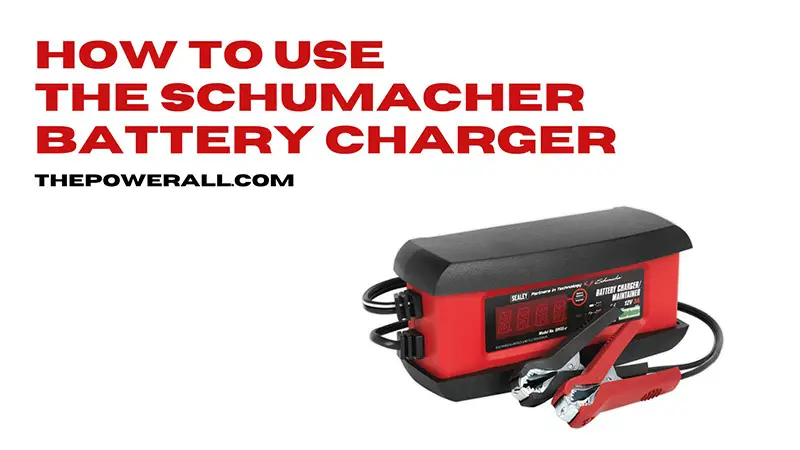

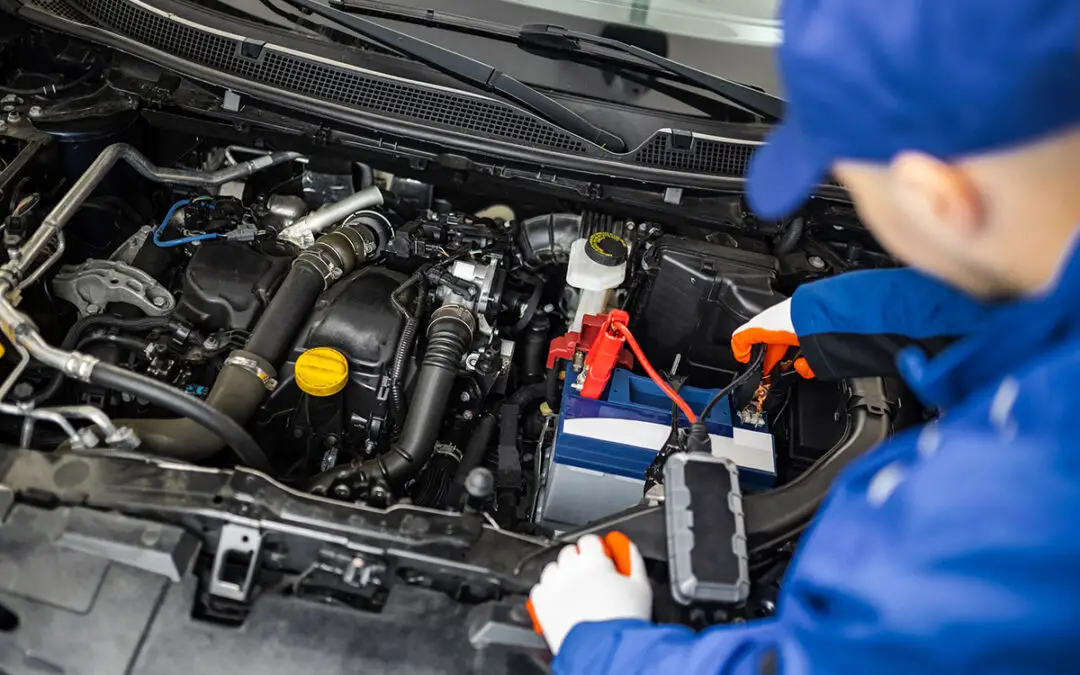
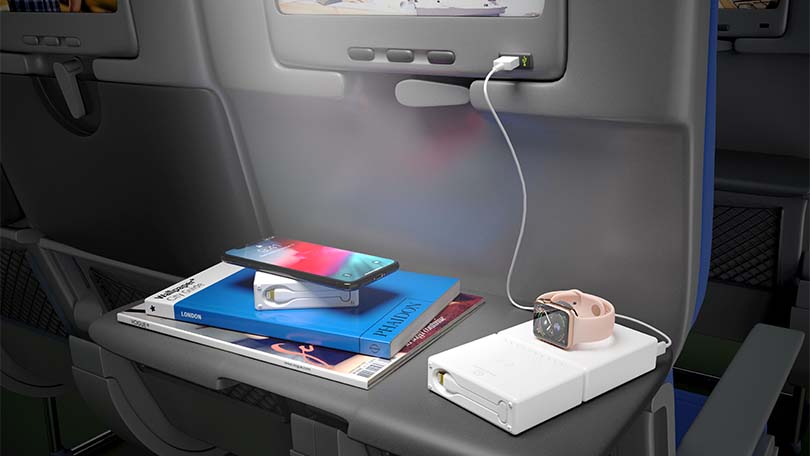



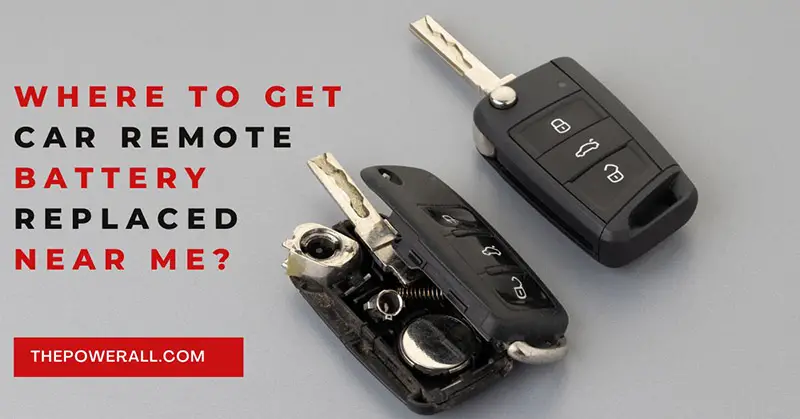
0 Comments